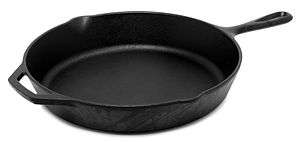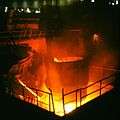Cast iron
| Steels and other iron–carbon alloy phases |
|---|
 |
| Microstructures |
| Classes |
| Other iron-based materials |
Cast iron is a group of iron-carbon alloys with a carbon content greater than 2%.[1] Its usefulness derives from its relatively low melting temperature. The alloy constituents affect its colour when fractured: white cast iron has carbide impurities which allow cracks to pass straight through; grey cast iron has graphite flakes which deflect a passing crack and initiate countless new cracks as the material breaks; ductile cast iron has spherical graphite "nodules" which stop the crack from further progressing.
Carbon (C) ranging from 1.8–4 wt%, and silicon (Si) 1–3 wt% are the main alloying elements of cast iron. Iron alloys with less carbon content are known as steel. While this technically makes the Fe–C–Si system ternary, the principle of cast iron solidification can be understood from the simpler binary iron–carbon phase diagram. Since the compositions of most cast irons are around the eutectic point (lowest liquid point) of the iron–carbon system, the melting temperatures usually range from 1,150 to 1,200 °C (2,100 to 2,190 °F), which is about 300 °C (540 °F) lower than the melting point of pure iron.
Cast iron tends to be brittle, except for malleable cast irons. With its relatively low melting point, good fluidity, castability, excellent machinability, resistance to deformation and wear resistance, cast irons have become an engineering material with a wide range of applications and are used in pipes, machines and automotive industry parts, such as cylinder heads (declining usage), cylinder blocks and gearbox cases (declining usage). It is resistant to destruction and weakening by oxidation (rust).
The earliest cast iron artefacts date to the 5th century BC, and were discovered by archaeologists in what is now Jiangsu in China. Cast iron was used in ancient China for warfare, agriculture, and architecture.[2] During the 15th century, cast iron became utilized for artillery in Burgundy, France, and in England during the Reformation.[3] The first cast iron bridge was built during the 1770s by Abraham Darby III, and is known as The Iron Bridge. Cast iron is also used in the construction of buildings.
Production
Cast iron is made by re-melting pig iron, often along with substantial quantities of iron, steel, limestone, carbon (coke) and taking various steps to remove undesirable contaminants. Phosphorus and sulfur may be burnt out of the molten iron, but this also burns out the carbon, which must be replaced. Depending on the application, carbon and silicon content are adjusted to the desired levels, which may be anywhere from 2–3.5% and 1–3%, respectively. Other elements are then added to the melt before the final form is produced by casting.
Cast iron is sometimes melted in a special type of blast furnace known as a cupola, but in modern applications, it is more often melted in electric induction furnaces or electric arc furnaces.[4] After melting is complete, the molten cast iron is poured into a holding furnace or ladle.
Types
Alloying elements

Cast iron's properties are changed by adding various alloying elements, or alloyants. Next to carbon, silicon is the most important alloyant because it forces carbon out of solution. A low percentage of silicon allows carbon to remain in solution forming iron carbide and the production of white cast iron. A high percentage of silicon forces carbon out of solution forming graphite and the production of grey cast iron. Other alloying agents, manganese, chromium, molybdenum, titanium and vanadium counteracts silicon, promotes the retention of carbon, and the formation of those carbides. Nickel and copper increase strength, and machinability, but do not change the amount of graphite formed. The carbon in the form of graphite results in a softer iron, reduces shrinkage, lowers strength, and decreases density. Sulfur, largely a contaminant when present, forms iron sulfide, which prevents the formation of graphite and increases hardness. The problem with sulfur is that it makes molten cast iron viscous, which causes defects. To counter the effects of sulfur, manganese is added because the two form into manganese sulfide instead of iron sulfide. The manganese sulfide is lighter than the melt so it tends to float out of the melt and into the slag. The amount of manganese required to neutralize sulfur is 1.7 × sulfur content + 0.3%. If more than this amount of manganese is added, then manganese carbide forms, which increases hardness and chilling, except in grey iron, where up to 1% of manganese increases strength and density.[5]
Nickel is one of the most common alloying elements because it refines the pearlite and graphite structure, improves toughness, and evens out hardness differences between section thicknesses. Chromium is added in small amounts to reduce free graphite, produce chill, and because it is a powerful carbide stabilizer; nickel is often added in conjunction. A small amount of tin can be added as a substitute for 0.5% chromium. Copper is added in the ladle or in the furnace, on the order of 0.5–2.5%, to decrease chill, refine graphite, and increase fluidity. Molybdenum is added on the order of 0.3–1% to increase chill and refine the graphite and pearlite structure; it is often added in conjunction with nickel, copper, and chromium to form high strength irons. Titanium is added as a degasser and deoxidizer, but it also increases fluidity. 0.15–0.5% vanadium is added to cast iron to stabilize cementite, increase hardness, and increase resistance to wear and heat. 0.1–0.3% zirconium helps to form graphite, deoxidize, and increase fluidity.[5]
In malleable iron melts, bismuth is added, on the scale of 0.002–0.01%, to increase how much silicon can be added. In white iron, boron is added to aid in the production of malleable iron; it also reduces the coarsening effect of bismuth.[5]
Grey cast iron
Grey cast iron is characterised by its graphitic microstructure, which causes fractures of the material to have a grey appearance. It is the most commonly used cast iron and the most widely used cast material based on weight. Most cast irons have a chemical composition of 2.5–4.0% carbon, 1–3% silicon, and the remainder iron. Grey cast iron has less tensile strength and shock resistance than steel, but its compressive strength is comparable to low- and medium-carbon steel. These mechanical properties are controlled by the size and shape of the graphite flakes present in the microstructure and can be characterised according to the guidelines given by the ASTM.[6]
White cast iron
White cast iron displays white fractured surfaces due to the presence of an iron carbide precipitate called cementite. With a lower silicon content (graphitizing agent) and faster cooling rate, the carbon in white cast iron precipitates out of the melt as the metastable phase cementite, Fe3C, rather than graphite. The cementite which precipitates from the melt forms as relatively large particles. As the iron carbide precipitates out, it withdraws carbon from the original melt, moving the mixture toward one that is closer to eutectic, and the remaining phase is the lower iron-carbon austenite (which on cooling might transform to martensite). These eutectic carbides are much too large to provide the benefit of what is called precipitation hardening (as in some steels, where much smaller cementite precipitates might inhibit plastic deformation by impeding the movement of dislocations through the pure iron ferrite matrix). Rather, they increase the bulk hardness of the cast iron simply by virtue of their own very high hardness and their substantial volume fraction, such that the bulk hardness can be approximated by a rule of mixtures. In any case, they offer hardness at the expense of toughness. Since carbide makes up a large fraction of the material, white cast iron could reasonably be classified as a cermet. White iron is too brittle for use in many structural components, but with good hardness and abrasion resistance and relatively low cost, it finds use in such applications as the wear surfaces (impeller and volute) of slurry pumps, shell liners and lifter bars in ball mills and autogenous grinding mills, balls and rings in coal pulverisers, and the teeth of a backhoe's digging bucket (although cast medium-carbon martensitic steel is more common for this application).
It is difficult to cool thick castings fast enough to solidify the melt as white cast iron all the way through. However, rapid cooling can be used to solidify a shell of white cast iron, after which the remainder cools more slowly to form a core of grey cast iron. The resulting casting, called a chilled casting, has the benefits of a hard surface with a somewhat tougher interior.
High-chromium white iron alloys allow massive castings (for example, a 10-tonne impeller) to be sand cast, as the chromium reduces cooling rate required to produce carbides through the greater thicknesses of material. Chromium also produces carbides with impressive abrasion resistance. These high-chromium alloys attribute their superior hardness to the presence of chromium carbides. The main form of these carbides are the eutectic or primary M7C3 carbides, where "M" represents iron or chromium and can vary depending on the alloy's composition. The eutectic carbides form as bundles of hollow hexagonal rods and grow perpendicular to the hexagonal basal plane. The hardness of these carbides are within the range of 1500-1800HV[7]
Malleable cast iron
Malleable iron starts as a white iron casting that is then heat treated for a day or two at about 950 °C (1,740 °F) and then cooled over a day or two. As a result, the carbon in iron carbide transforms into graphite and ferrite plus carbon (austenite). The slow process allows the surface tension to form the graphite into spheroidal particles rather than flakes. Due to their lower aspect ratio, the spheroids are relatively short and far from one another, and have a lower cross section vis-a-vis a propagating crack or phonon. They also have blunt boundaries, as opposed to flakes, which alleviates the stress concentration problems found in grey cast iron. In general, the properties of malleable cast iron are more like those of mild steel. There is a limit to how large a part can be cast in malleable iron, as it is made from white cast iron.
Ductile cast iron
Developed in 1948, nodular or ductile cast iron has its graphite in the form of very tiny nodules with the graphite in the form of concentric layers forming the nodules. As a result, the properties of ductile cast iron are that of a spongy steel without the stress concentration effects that flakes of graphite would produce. Tiny amounts of 0.02 to 0.1% magnesium, and only 0.02 to 0.04% cerium added to these alloys slow the growth of graphite precipitates by bonding to the edges of the graphite planes. Along with careful control of other elements and timing, this allows the carbon to separate as spheroidal particles as the material solidifies. The properties are similar to malleable iron, but parts can be cast with larger sections.
Table of comparative qualities of cast irons
| Name | Nominal composition [% by weight] | Form and condition | Yield strength [ksi (0.2% offset)] | Tensile strength [ksi] | Elongation [% (in 2 inches)] | Hardness [Brinell scale] | Uses |
|---|---|---|---|---|---|---|---|
| Grey cast iron (ASTM A48) | C 3.4, Si 1.8, Mn 0.5 | Cast | — | 50 | 0.5 | 260 | Engine cylinder blocks, flywheels, gearbox cases, machine-tool bases |
| White cast iron | C 3.4, Si 0.7, Mn 0.6 | Cast (as cast) | — | 25 | 0 | 450 | Bearing surfaces |
| Malleable iron (ASTM A47) | C 2.5, Si 1.0, Mn 0.55 | Cast (annealed) | 33 | 52 | 12 | 130 | Axle bearings, track wheels, automotive crankshafts |
| Ductile or nodular iron | C 3.4, P 0.1, Mn 0.4, Ni 1.0, Mg 0.06 | Cast | 53 | 70 | 18 | 170 | Gears, camshafts, crankshafts |
| Ductile or nodular iron (ASTM A339) | — | cast (quench tempered) | 108 | 135 | 5 | 310 | — |
| Ni-hard type 2 | C 2.7, Si 0.6, Mn 0.5, Ni 4.5, Cr 2.0 | Sand-cast | — | 55 | — | 550 | High strength applications |
| Ni-resist type 2 | C 3.0, Si 2.0, Mn 1.0, Ni 20.0, Cr 2.5 | Cast | — | 27 | 2 | 140 | Resistance to heat and corrosion |
History
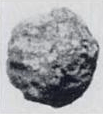
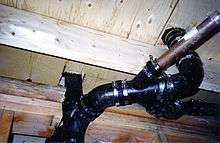

The earliest cast iron artifacts date to the 5th century BC, and were discovered by archaeologists in what is now modern Luhe County, Jiangsu in China. This is based on an analysis of the artifact's microstructures.[2] Because cast iron is comparatively brittle, it is not suitable for purposes where a sharp edge or flexibility is required. It is strong under compression, but not under tension. Cast iron was invented in China in the 5th century BC and poured into moulds to make ploughshares and pots as well as weapons and pagodas.[9] Although steel was more desirable, cast iron was cheaper and thus was more commonly used for implements in ancient China, while wrought iron or steel was used for weapons.[2]
In the west, where it did not become available until the 15th century, its earliest uses included cannon and shot. Henry VIII initiated the casting of cannon in England. Soon, English iron workers using blast furnaces developed the technique of producing cast iron cannons, which, while heavier than the prevailing bronze cannons, were much cheaper and enabled England to arm her navy better. The technology of cast iron was transferred from China. Al-Qazvini in the 13th century and other travellers subsequently noted an iron industry in the Alburz Mountains to the south of the Caspian Sea. This is close to the silk route, so that the use of technology derived from China is conceivable.[10] The ironmasters of the Weald continued producing cast irons until the 1760s and armament was one of the main uses of irons after the Restoration.
Cast iron pots were made at many English blast furnaces at the time. In 1707, Abraham Darby patented a method of making pots (and kettles) thinner and hence cheaper than his rivals could. This meant that his Coalbrookdale furnaces became dominant as suppliers of pots, an activity in which they were joined in the 1720s and 1730s by a small number of other coke-fired blast furnaces.
The development of the steam engine by Thomas Newcomen provided further market for cast iron, since cast iron was considerably cheaper than the brass of which the engine cylinders were originally made. John Wilkinson was a great proponent of cast iron, who, amongst other things, cast the cylinders for many of James Watt's improved steam engines until the establishment of the Soho Foundry in 1795.
Cast-iron bridges
The use of cast iron for structural purposes began in the late 1770s, when Abraham Darby III built the Iron Bridge, although short beams had already been used, such as in the blast furnaces at Coalbrookdale. Other inventions followed, including one patented by Thomas Paine. Cast iron bridges became commonplace as the Industrial Revolution gathered pace. Thomas Telford adopted the material for his bridge upstream at Buildwas, and then for a canal trough aqueduct at Longdon-on-Tern on the Shrewsbury Canal.
It was followed by the Chirk Aqueduct and the Pontcysyllte Aqueduct, both of which remain in use following the recent restorations. Cast iron beam bridges were used widely by the early railways, such as the Water Street Bridge at the Manchester terminus of the Liverpool and Manchester Railway. Problems arose when a new bridge carrying the Chester and Holyhead Railway across the River Dee in Chester collapsed in May 1847, less than a year after it was opened. The Dee bridge disaster was caused by excessive loading at the centre of the beam by a passing train, and many similar bridges had to be demolished and rebuilt, often in wrought iron. The bridge had been erroneously designed, being trussed with wrought iron straps, which were wrongly thought to reinforce the structure. The centres of the beams were put into bending, with the lower edge in tension, where cast iron, like masonry, is very weak.
The best way of using cast iron for bridge construction was by using arches, so that all the material is in compression. Cast iron, again like masonry, is very strong in compression. Wrought iron, like most other kinds of iron and indeed like most metals in general, is strong in tension, and also tough – resistant to fracturing. The relationship between wrought iron and cast iron, for structural purposes, may be thought of as analogous to the relationship between wood and stone.
Nevertheless, cast iron continued to be used in inappropriate structural ways, until the Tay Rail Bridge disaster of 1879 cast serious doubt on the use of the material. Crucial lugs for holding tie bars and struts in the Tay Bridge had been cast integral with the columns and they failed in the early stages of the accident. In addition, the bolt holes were also cast and not drilled, so that all the tension from the tie bars was placed on a corner, rather than being spread over the length of the hole. The replacement bridge was built in wrought iron and steel.
Further bridge collapses occurred, however, culminating in the Norwood Junction rail accident of 1891. Thousands of cast iron rail underbridges were eventually replaced by steel equivalents.
 Original Tay Bridge from the north
Original Tay Bridge from the north- Fallen Tay Bridge from the north
 Iron Bridge over the River Severn at Coalbrookdale, England
Iron Bridge over the River Severn at Coalbrookdale, England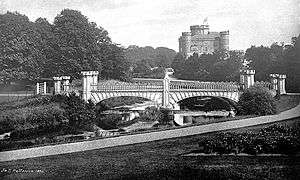
Buildings
Cast iron columns enabled architects to build tall buildings without the enormously thick walls required to construct masonry buildings of any height. Such flexibility allowed tall buildings to have large windows. In urban centres like SoHo-Cast Iron Historic District in New York City, manufacturing buildings and early department stores were built with cast iron columns to allow daylight to enter. Slender cast iron columns could also support the weight that would otherwise require thick masonry columns or piers, opening up floor spaces in factories, and sight lines in churches and auditoriums. The historic Iron Building in Watervliet, New York, is a cast iron building.
Textile mills
Another important use was in textile mills. The air in the mills contained flammable fibres from the cotton, hemp, or wool being spun. As a result, textile mills had an alarming propensity to burn down. The solution was to build them completely of non-combustible materials, and it was found convenient to provide the building with an iron frame, largely of cast iron, replacing flammable wood. The first such building was at Ditherington in Shrewsbury, Shropshire. Many other warehouses were built using cast iron columns and beams, although faulty designs, flawed beams or overloading sometimes caused building collapses and structural failures.
During the Industrial Revolution, cast iron was also widely used for frame and other fixed parts of machinery, including spinning and later weaving machines in textile mills. Cast iron became widely used, and many towns had foundries producing industrial and agricultural machinery.
See also
- Cast-iron architecture
- Cast-iron cookware
- Ironwork — artisan metalwork: for architectural elements, garden features, and ornamental objects.
- Ironworks — a place where iron is worked (including historical sites)
- Meehanite
- Sand casting
- Steel
- Wrought iron
References
- ↑ Campbell, F.C. (2008). Elements of Metallurgy and Engineering Alloys. Materials Park, Ohio: ASM International. p. 453. ISBN 978-0-87170-867-0.
- 1 2 3 Donald B. Wagner (1993). Iron and Steel in Ancient China. BRILL. pp. 335–340. ISBN 978-90-04-09632-5.
- ↑ Keith Krause (August 1995). Arms and the State: Patterns of Military Production and Trade. Cambridge University Press. p. 40. ISBN 978-0-521-55866-2.
- ↑ Singh, Bijender (April 2011). "RESEARCH OF CAST IRON IN ACIDIC MEDIUM IN THE INDUSTRIAL FIELD AS COMPONENTS IN ACID PICKLING" (PDF). International Journal of Research in Science And Technology. Retrieved April 11, 2016.
- 1 2 3 Gillespie, LaRoux K. (1988). Troubleshooting manufacturing processes (4th ed.). SME. p. 4-4. ISBN 978-0-87263-326-1.
- ↑ Committee, A04. "Test Method for Evaluating the Microstructure of Graphite in Iron Castings". doi:10.1520/a0247-10.
- ↑ Zeytin, Havva. "Effect of Boron and Heat Treatment on Mechanical Properties of White Cast Iron for Mining Application". Journal of Iron and Steel Research, International. 18 (11): 31–39.
- ↑ Lyons, William C. and Plisga, Gary J. (eds.) Standard Handbook of Petroleum & Natural Gas Engineering, Elsevier, 2006
- ↑ Donald B. Wagner (May 2008). Science and Civilisation in China: Volume 5, Chemistry and Chemical Technology, Part 11, Ferrous Metallurgy. Cambridge University Press. pp. 159–169. ISBN 978-0-521-87566-0.
- ↑ Donald B. Wagner (continuing from Joseph Needham), Science and Civilisation in China: 5. Chemistry and Chemical Technology: part 11 Ferrous Metallurgy (Cambridge University Press 2008), 349–51.
Further reading
- Harold T. Angus, Cast Iron: Physical and Engineering Properties, Butterworths, London (1976) ISBN 0408706880
- John Gloag and Derek Bridgwater, A History of Cast Iron in Architecture, Allen and Unwin, London (1948)
- Peter R Lewis, Beautiful Railway Bridge of the Silvery Tay: Reinvestigating the Tay Bridge Disaster of 1879, Tempus (2004) ISBN 0-7524-3160-9
- Peter R Lewis, Disaster on the Dee: Robert Stephenson's Nemesis of 1847, Tempus (2007) ISBN 978-0-7524-4266-2
- George Laird, Richard Gundlach and Klaus Röhrig, Abrasion-Resistant Cast Iron Handbook, ASM International (2000) ISBN 0-87433-224-9
External links
| Wikimedia Commons has media related to Cast iron. |
- Cast Iron In China and Europe
- Metallurgy of Cast Irons, Cambridge University
- Forensic engineering:the Tay Bridge disaster
- Spanish cast-iron bridges
